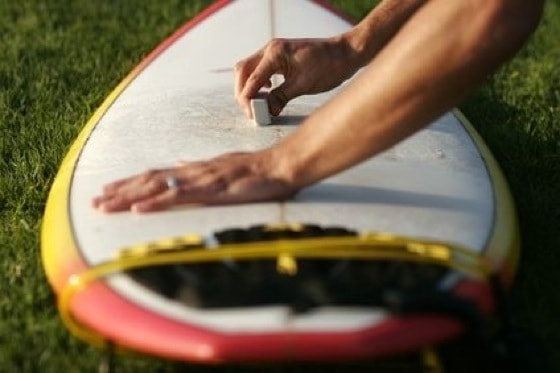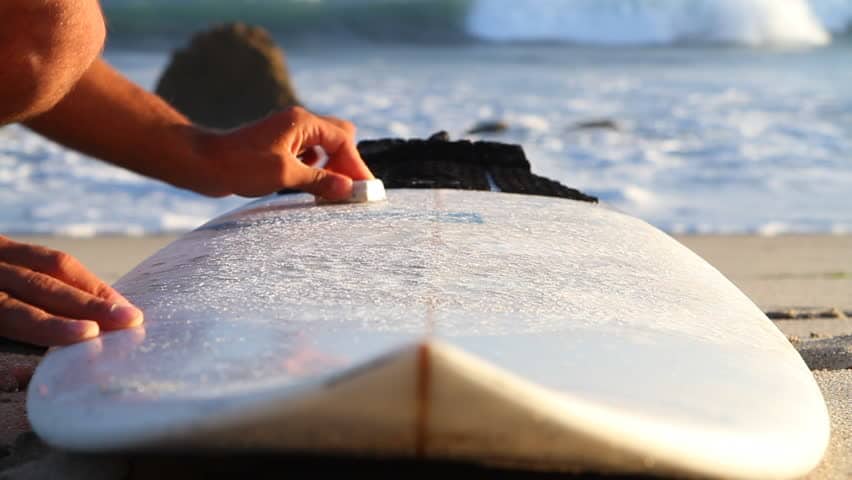When you surf, you are constantly in the water. Imagine driving your car during a rainstorm. How does the car react when you apply the brakes hard to avoid an accident? The car slips. Surfers have to exercise care when surfing, so they make some extra precautions to avoid accidents.
Why do surfers put surf wax on their surfboards? Surfers put wax on their boards because wax prevents surfers from slipping off their surfboards. They use surf wax for traction.
Surf wax is a sticky substance and helps keep feet stuck to the surfboard surface. Surf wax repels water but does not have a slippery feel like car wax. When rubbed on the surfboard, the wax is softened by the rubbing motion when applying it. Surf wax adheres to the surfboard deck and is barely noticeable on the surface of the board.
What Is Surf Wax Made From?
Surf wax has undergone several ingredient changes in the last few decades. When surf wax is applied, it literally “melts” onto the surfboard in such a way that you hardly know it’s there.
Surfers represent the American dream, but not for surfing. It is the pursuit of what you believe in, and the general acceptance that you can focus on your destiny no matter what it is. California, the main hub for surfers in the United States, encourages people to pursue their life’s passion. Surfers are challenged and when they get to be surrounded by the spiraling vortex of a massive wave, there is an untranslatable feeling of accomplishment.
Surfing is about overcoming obstacles and the obstacle surfers face is nature. As such, most surfers have a passion for the environment and will refuse to use any product that contains ingredients that will damage nature.
The top-rated environmentally friendly surf wax on the market today is Mr. Zog’s Sex Wax. The product contains no beeswax, so it’s cruelty-free and animal friendly. Its all-natural ingredients include paraffin wax, petroleum jelly, and microcrystalline wax.
What Is The Best Way To Wax A Surfboard?
New surfers will buy their first board and don’t wax it first. They run out to the ocean, impatient to get onto the water. More experienced surfers watch them tumble into the sea over and over again, shaking their heads. They were novices at surfing once and made the same mistake. In any case, don’t go into the surf without waxing your surfboard first.
You will notice there are a lot of steps involved in waxing your surfboard the first time. After a few applications of the wax, it will become second nature and you’ll hardly be thinking about what you’re doing.
It’s important to remove the old wax from the surfboard before applying new wax. This is wax left on after purchasing a used board, or the wax on the board from the previous waxing.
You will need the following supplies to wax your surfboard.
- Surfboard wax remover
- Paper towels
- Surf comb
- Base wax
- Mr. Zog Sex Wax (for the topcoat).
Remove old wax
Old wax adheres tightly to the surfboard material, so there are steps to take to make it easier to get off. First, place the surfboard in the sun with the waxed side facing the sky. Don’t leave it out in the sun for too long; the heat will make the surfboard decay form the inside of the board and out to the surface.
It’s a good idea to use mineral spirits to loosen up the old wax. You can give it about 20 minutes in the hot sun before applying the mineral wax.
Once the board is soft, use a surf comb and scrape away the old wax. Use a soft cloth with mineral spirits if the wax is sticky and tacky. Make sure to remove all the old wax, otherwise, your new wax will not adhere to the board surface properly.
Now that all the old wax has been removed, it’s time to apply the new coat. Waxing using the basecoat is a different process, depending on the board you’re using.
Apply the basecoat wax to the board
How you apply the basecoat depends on what kind of surfboard you use.
| Shortboard | Between 5’ 5” and 6’ 5”; 18-19 inches wide |
| Longboard | Between 9 and 10 feet |
| Funboard | 7 to 8 feet; 22 inches in width |
| Fish | Less than 6 feet long |
| Gun | Between 7 and 9 feet |
95% of all surfers use the shortboard, while most of the remainder use the longboard. The funboard is a bit wider than the shortboard and a little longer. The gun board is designed for surfers who have been riding waves for years, so it’s assumed that they know how to wax their boards. We’ll focus on waxing the shortboard and the longboard.
Note that you can do without applying a basecoat, but the top wax won’t last very long if you skip this step. Also, the topcoat won’t adhere to the board as well if you don’t use the right basecoat. You don’t want to have “naked spots” on the board where you can slip and fall off in the water.
Keep the basecoat on the board until you re-wax it. This is because the topcoat adheres to the basecoat.

Longboards: Wax the topside completely, from nose to tail and all the way to each edge.
Shortboards: wax from the front logo topside to the back edge, which is about 2/3 the length of the board. Make sure to apply the basecoat from edge to edge too.
There are 4 different ways to apply the basecoat. Choose which one works best for making the basecoat wax stick to the board.
Waxing in circles. Take a good amount of the wax in a small cloth, but not too much. Rub the wax in small circles and move up the board after you’ve covered your spot from edge to edge.
Waxing in a straight line pattern. In straight lines, wax the board in an up and down motion that runs to the locker in parallel. This means to rub along the length of the surfboard.
Wax the entire right side of the board from nose to tail, then wax the left side in its entirety.
Crosshatch pattern. Here, you rub wax onto the surfboard in a diagonal pattern, followed by a perpendicular pattern. This completes the crosshatch waxing approach.
Diagonal goes from the edge closest to you then upwards towards the other edge. Next, start with the edge furthest from you and in a straight line from where you started and go up diagonally to the edge closest to you. It’s like drawing an X.
You next wax perpendicular to the X, at 90 degree angles to the diagonal lines you created. Imagine you are drawing a tic tac toe board.
Waxing in the “kitchen sink” pattern. This approach is waxing using a combination of all 4 rubbing patterns at once. Once you’ve gained experience waxing your surfboard, you may come up with your own pattern that you’ll want to use.
Keep applying the basecoat until you see bumps forming in the wax. Use the edge of the wax stick tool (its narrowest side). The topcoat wax will naturally adhere to the bumps in the basecoat wax.
Apply the topcoat
Apply the wax over the exact areas where you applied the basecoat. Rub the wax edge onto the board in small circles about 4 inches in diameter. Use one of the 4 application methods described earlier.
It’s a lot easier to use a topcoat wax that’s a different color than the basecoat wax. If you use the same color, it will be harder to tell what areas you’ve covered with the topcoat.
When you’ve finished, get a spray bottle and spray cool water on the board. This helps the wax to harden so it sticks to the board better.
Next, comb the wax with a wax comb. Use the crosshatch method when combing the wax. Do this to rough up the wax a little. This will permit you to grip your board better. Make sure you comb through all the wax on the surfboard.
Related Questions
How Often Should I Wax My Surfboard?
Generally speaking, you should wax your surfboard at least 4 times a year, once at the beginning of each season.
If you surf every day, you should wax the board more often. Some obsessive surfers wax the board each time they go surfing. That may not be necessary, though. You can tell when the board needs to be waxed as soon as your feet begin to lose its firm grip on the board. If you slip and slide, it’s time to wax it again.
A lot of surfers wax their boards once a month. If you can get into the habit of waxing every 30 days, then you should. There is no harm, the board will always be ready to use, and you can’t over-wax your surfboard.
Can I Wax My Surfboard In The Sun?
Do not wax your surfboard in the sun. The sun interacts with the ingredients of the basecoat and the topcoat, causing the wax to dry too fast and become rough. Always wax your board in the shade or stay out of direct sunlight at least.
It’s highly advised to keep your surfboard out of the sun at all times when you’re not using it. Although surfing is done under the rays of the sun, it is constantly in water, which acts as a barrier between the surfboard and the sun. Keep your surfboard in the shade after when you’re not riding it.
Can I Leave My Surfboard In My Car?
Like your pet dog, don’t leave your surfboard in the car. Inside a car in summer, temperatures rise to up to 150 degrees. The combination of heat and sun can permanently warp your surfboard.
Leaving your board on your car roof is not advisable either, because it’s exposed to the sun’s rays.
Remember always to keep the waxed side down and away from the sun when you’re outside.

